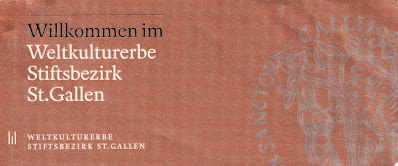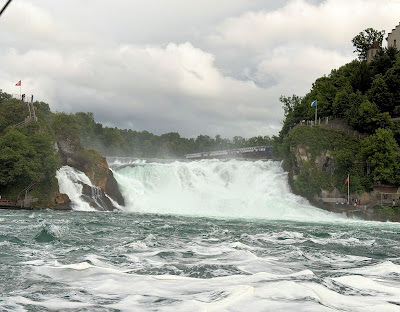The bus ride through the pre-summer landscape was pleasant. Our first stop was St. Gallen, where we got off at the Einstein parking lot. Einstein? What did he have to do with St. Gallen?

|
| Advertising a musical |
So my first question to the hostesses was: What does Einstein have to do with St. Gallen? No one could answer me. Finally, ChatGPT came to the rescue: There is no known special or outstanding relationship between Albert Einstein and the city of St. Gallen.
Before visiting the famous abbey library, the actual destination of our trip, our group set off on a walk through the city.

|
| The monastery district |

|
| Workers in the "bleaching fields." Painting of the mid-17th century |
Thanks to rigorous quality controls, the white linen from St. Gall was the finest available and was traded throughout Europe.
Around 610, the Irish monk Gallus came to what is now Switzerland to convert the Alemanni to Christianity. His grave soon became a popular place of pilgrimage, where in 719 the Alemannic priest Otmar founded the Abbey of St. Gallen.
Since its foundation, the monastery has rapidly gained influence. In a donation around the year 720, vineyards in Ebringen, a village south of Freiburg, were bequeathed to the monastery. This deed of donation is the oldest document kept in the Stiftsbibliothek St. Gallen. It represents the first real estate acquired outside the monastery and is the oldest written evidence of viticulture between Freiburg and Basel.
During our tour of the city, I took the above photo of grapes on a stone house. When I asked our guide, he explained that in the past, only wine drinkers could afford stone houses because they were "steinreich" (stone rich).
He then continued that the well-known German saying "Wein auf Bier, das rat' ich dir, Bier auf Wein, das lass sein" (Wine after beer, that's what I advise; beer after wine, that's what I dissuade) does not mean that the two drinks must be consumed in a specific order for the total drink to be digestible.
Indeed, there is another English translation, "Wine after beer, that's my
choice; beer after wine, never be a slave again," with the correct German
meaning describing the social rise or fall of citizens, as identified through
their choice of drink.
During St. Gallen's heyday, there were four breweries on the grounds of the monastery. Beer was the drink for the masses, as only citizens who had become wealthy through the trade in white linen could afford expensive wine.
In 1526, the then-mayor and humanist Joachim Vadian introduced the Reformation in St. Gallen.
During St. Gallen's heyday, there were four breweries on the grounds of the monastery. Beer was the drink for the masses, as only citizens who had become wealthy through the trade in white linen could afford expensive wine.
In 1526, the then-mayor and humanist Joachim Vadian introduced the Reformation in St. Gallen.

|
|
Matthäus Merian:Topographia Helvetiae, Rhaetiae, et Valesiae. St.
Gallen in 1642. Note that the Schiedmauer surrounds the monastery grounds on the left (©Wikipedia/sidonius) |
The quality of St. Gallen linen was good, but it was also expensive. Soon, cheaper competition emerged, including sheets made from cotton. Fewer and fewer white clothes were ordered. By 1798, the bleaching fields outside the city were empty.
St. Gallen experienced a second boom in the early 19th century, when machines began to replace hand embroidery. Many farmers from the surrounding area had such a machine installed on their farms in exchange for a down payment. They supplemented their meager income with the help of their wives and children. Around 1910, the embroidery was the largest export industry in Switzerland, accounting for 18% of the country's total exports. Over 50% of global production came from St. Gallen.
Why is St. Gallen's famous library called "Stiftsbibliothek" (endowed library) and not "Klosterbibliothek" (monastery library)?
Napoleon is to blame for this, as he is for everything else. In the Reichsdeputationshauptschluss (Imperial Recess) of 1803, he ordered the secularization of all ecclesiastical institutions in his territory to satisfy the territorial claims of his allies during the reorganization of Europe.
So, monasteries, when they survived, somehow became endowments.

|
| Entering the Stiftsbibliothek in felt slippers |

|
| Vow! |
Immense treasures are on display here:

|
| Around 980 |

|
| In 1125 |

|
| 1200 to 1300 |

|
| Around 1510 |
The above picture shows a neume notation, the precursor to today's
musical notation.

|
| Apple was here, still unbitten. |

|
| St. James's scallops showed the way to the Stiftskirche |

|
| Unpretentious Baroque |

|
| Triumphant Christ with St. George's banner or Freiburg's colors? |

|
| Erie reflections in the baptismal font |

|
| OLMA Bratwurst, Rösti, onion gravy, and St. Galler monastery beer |
*This acronym initially stood for Ostschweizerische Land-
und Milchwirtschaftliche Ausstellung and is now the annual Schweizer Messe für Landwirtschaft und Ernährung (Swiss Fair for Aagriculture and Nutrition)






No comments:
Post a Comment